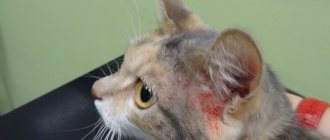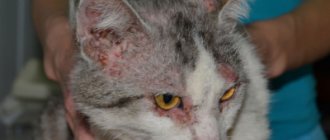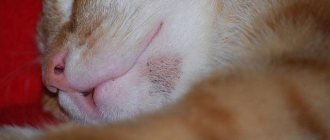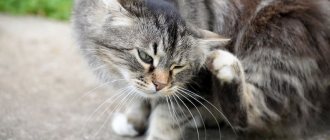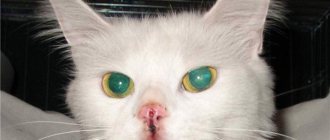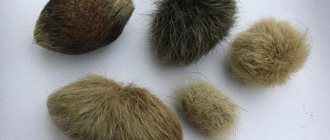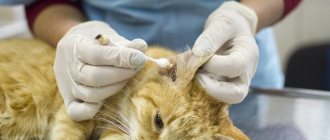Hair loss in cats is a common and even natural phenomenon. All representatives of the cat family are prone to changing coats. Regardless of whether a cat has long or short hair, it will shed. The only exceptions are breeds that do not have fur.
The main function that wool performs is protection from adverse factors and thermoregulation. With the onset of warmer weather, the cat's fur changes, the undercoat sheds, and the animal tolerates high temperatures more easily.
Coat renewal also occurs in the period before the onset of cold weather. The animal begins to acquire an undercoat that can retain body heat for a long time, preventing the pet from freezing.
The owner of the cat must clearly distinguish when hair loss is normal, and in which case shedding will indicate pathological conditions in the pet’s body.
Constant hair loss, and even in clumps, requires immediate contact with a veterinary clinic. During a clinical examination and laboratory tests, the doctor will be able to determine the exact cause of sudden hair loss and prescribe treatment appropriate for each specific case.
Where does a cat have bald spots? Why are bald spots dangerous on a cat?
Not only people, but also animals can suffer from baldness.
Bald spots in cats are a fairly common occurrence, which in most cases does not bother the pet, but frightens the owner. And not in vain, because baldness in a cat can appear for several reasons, including due to certain diseases. Most often, bald spots in cats appear due to vitamin deficiency. Poor or improper nutrition, lack of vitamin A leads to the fact that the blood supply to the hair follicles deteriorates and focal hair loss begins. Uninformed people may confuse the process with shedding, but in the second case the hair subsequently grows back, but with baldness it does not.
In some cases, a cat may develop baldness due to excessive grooming; frequent washing leads to weakening of the hair follicles. Because of this, the hair begins to gradually fall out. The same result can be caused by the use of low-quality shampoos or an allergic reaction to any medications.
Diseases of the endocrine system can also cause focal baldness, so-called endocrine alopecia. It should be noted that hormonal imbalance can be caused by several reasons: diabetes, sterilization, disorders of the thyroid gland or adrenal cortex.
Oddly enough, when bald spots appear, the first thing you need to do is examine the cat for fleas. Due to severe itching caused by an insect bite, the cat itself may gnaw out the hair on the affected areas.
Some skin diseases also lead to patchy baldness.
With fungal infections (microsporia, trichophytosis), small wounds, scabs, and crusts can be seen on bald spots. If an animal has scabies, then, in addition to alopecia, you can observe redness of the skin, and in especially severe cases, pyogenic inflammation.
Ringworm and oily seborrhea can also lead to bald patches. In these cases, a small rash and scratches appear on the animal’s skin, and the body temperature may rise.
Diseases of the stomach, liver, frequent digestive disorders, in addition to the main symptoms, can manifest as partial baldness, usually in the tail area.
There is also such a thing as psychogenic alopecia, when partial baldness occurs due to severe stress, and for each animal the concept of “strong” is individual - for one it may be a trip to the veterinarian, for another a banal change in food.
Treatment for baldness consists, first of all, in eliminating the root cause of the disease. The use of drugs whose action is aimed at improving the quality of the coat may give a temporary effect, but will not eliminate the problem and after some time the cat will begin to go bald again, and the intensity of the baldness may increase significantly.
In order to completely cure alopecia, the pet owner will have to be patient, since the process is far from quick. In addition to medications that eliminate the root cause of the disease, it will be necessary to administer vitamin therapy and provide the animal with a complete, balanced diet.
At home, bald spots on the body can be treated by rubbing camphor alcohol into the skin, using warm water compresses or alkaline soap solutions. Procedures such as darsonvalization and electrophoresis will be no less useful.
Having discovered bald spots on a cat, it is best for the owner not to self-medicate, but to show the animal to a veterinarian as soon as possible. The specialist will conduct the necessary research, make a diagnosis and prescribe treatment appropriate to the case.
List of drugs for the treatment of dermatitis in cats
After determining the factor that caused the damage to the skin and coat, the veterinarian may prescribe one of the drugs or a combination:
- Cortavance , Exekan to relieve itching and inflammation.
- Sinulox to eliminate bacterial infection.
- Terbinafine or Lyme sulfur against fungi.
- Shampoo for itching or inflammation. For example, Green Doctor, Globalvet with chlorhexedine.
- Drops on the withers against parasites: Broadline, Inspector, Bravecto.
- Ointments, creams or emulsions, for example Fucidin.
- Vitamins and other nutrients for speedy skin restoration, for example Laveta super or Supercoat.
- Veterinary diet from Royal Canin, Hills, Proplan, Monge or Farmina aimed at improving the quality of coat and dermis.
Watch the video: Veterinarian talks about sores on a cat’s neck
What to do immediately if you discover baldness on a pet
For reference! It doesn't matter what breed the cat is, all breeds lose hair, including hair from the neck. Neither flock or velor sphinxes, nor other noble breeds, nor farm animals with stronger immunity are immune from this phenomenon.
© shutterstock
Why is this happening? In order to answer this question, you need:
- Completely examine the animal, and not only the neck, but also all its parts: ears, paws, tail.
- Pay close attention to any damage to your cat's skin. Perhaps there is no baldness there, but there are wounds similar to those on the neck.
- Analyze how you care for your pet. This may be the reason why your cat is losing hair on its neck. Therefore, it is advisable to make a list of the foods you keep your cat on. Add care products, such as shampoo, to the list. Remember and write down whether you give your cat medications: fleas, worms, vitamins, contraceptives or behavior-correcting medications.
Why is all this important? To accurately diagnose and begin treatment.
What are the causes of hair loss
The fact that a cat's neck hair is falling out is a sign of illness. What could it be? There are only 3 options:
- Skin problem,
- Internal diseases of organs,
- Stress.
Skin problems. Problems can also arise due to injection with a syringe. A lump forms under the cat's skin, causing hair to fall out. Contact dermatitis is another cause. This is a cat's reaction to allergens. But due to fleas and lichen, hair on the cat’s neck, back or tummy can also fall out greatly.
Organ diseases. Thyroid disease, blood problems, hormonal imbalances - all this becomes a serious problem due to which the pet suffers, and, as a result of the disease, hair loss on the neck and body.
© shutterstock
Stress. Any change in a cat's life leads to stress. For example, a bald spot may appear when moving to a country house or changing food. This also includes age-related changes, the birth of children, etc. But most often, hair falls out not only on the neck, but also behind the ear and near the eyes. In this case, you can often observe that the hair on the cat’s neck falls out in clumps.
The cat itches until it hurts and the hair falls out: How to treat it at home?
Every owner should understand that many drugs that can be used by humans and other animals cannot be used on cats.
For example, skin lesions are often treated with Yam BK ointment. This is strictly forbidden, since the tar contained in this drug is toxic to cats.
Like this article? Read other materials about cats on our website: How to give medicine to a cat? Tips for ensuring comfort for a cat - How to learn to understand your cat (Practical tips) -
How can you help yourself without causing harm?
Try to limit access to the body area if the cat injures itself. A protective collar or blanket can help with this.
Trim your cat's claws or apply safe anti-scratch pads.
Itching can be controlled using a suspension or spray with the same name Stop Itching . It is important to understand that you will only remove the symptom, and after a course of the drug the problem may return.
The crusts can be soaked and removed using saline or Chlorhexedine.
Also, if there has been no treatment for fleas and ticks for a long time (the apple tree is a month old), it is worth doing it. Suitable drugs: Stronghold, Lawyer, Helmintal, Inspector, Bravecto.
And, of course, we recommend taking your pet to see a doctor as soon as possible.
What measures are needed to prevent the problem?
The problem has been identified, the cat is scratching its neck and hair is coming out. And the bald patches all over the baby’s body say that you can’t cope with the problem on your own. What to do? The best thing to do is go to a veterinary clinic. An accurate diagnosis is needed. Tests and monitoring of the cat’s general condition will help you find out exactly what is causing hair loss from the kitten’s neck.
You may have to change the food or cleanse your pets of parasites. Only a doctor can decide whether vitamins or medications are needed to treat your cat.
Cat owners know that from time to time they have to collect cat hair around the house, as the period of natural hair loss begins. But why do some cats have too much fluffy cover, and even bald patches form near the tail or on the tummy and paws?
Severe hair loss is not normal; you should definitely pay attention to it and seek advice from a specialist. But don’t be alarmed right away; perhaps the animal is lacking vitamins or this is how a skin disease manifests itself.
The veterinarian will diagnose why the cat’s hair is falling out and bald spots are forming, prescribe treatment, and explain preventive measures. If the cat sheds hair, but new hairs immediately grow, then it’s just shedding season.
Reasons for the appearance of bald spots in cats
Usually, due to illness or other physiological disorders in the animal's body, a bald spot remains on the neck, near the hind legs. Only after an examination at a veterinary clinic can the causes of baldness in cats be determined.
- Cat baldness can appear due to allergies to medications, certain types of food or products, or to hair care products.
- The fur sometimes peels off due to insect bites; not all cat owners know about this. Flea bites may not go away without leaving a trace, although they are considered something minor.
- If your furry pet's back or other part of the body is peeling, this may indicate that the animal has experienced severe stress - fright, for example, or moving to a new place of residence.
- Among the causes of baldness are endocrine diseases, abdominal trauma, and pyoderma.
- Specific causes include feline symmetrical alopecia.
It is necessary to ensure that the cat does not lick the fur on its belly and paws too diligently and often; this can also cause damage to the hair follicles, their weakening, and hair loss.
How to treat hair loss in cats
If a cat has a bald patch on its stomach, hind legs, tail, or if severe hair loss is noticeable, a veterinarian’s help is needed in solving the problem. If such a symptom is ignored, serious diseases can develop into a more complex condition of the animal.
The choice of means and methods of treatment depends on the diagnosis of the cause of the disease.
- Did the bald spot appear at the site of a flea bite? This painful area should be treated with an insecticidal agent. The doctor will recommend which one.
- If you have a food allergy, first eliminate the source of the allergic reaction. At the same time, the veterinarian prescribes antihistamines.
- You may also be allergic to dust, in which case you should do wet cleaning in the house more often, especially in those rooms where your pet spends time.
- If the cause of bald spots is chronic pancreatitis, without curing this disease it is impossible to restore the thickness of the coat. Treatment is aimed at eliminating pain, combating dehydration, and reducing destructive secretions. Swelling should be relieved and pancreatic function should be slowed down.
- In case of hyperthyroidism and hypothyroidism, first of all, it is necessary to restore the balance of thyroid hormones. Treatment of the first disease involves taking medications that also support the functioning of the kidneys and heart and inhibit the production of thyroid hormones. If hypothyroidism is to be treated, medications are needed to slow down the binding of serum proteins.
Only after restoring the balance of hormones can we expect the elimination of bald spots in a cat.
In the most severe cases, the veterinarian decides on surgical intervention. After surgery, the cat owner must feed her according to the prescribed diet, which includes foods with enveloping properties.
Alopecia, or feline hair loss: what is it?
All cats shed twice a year, and this is the norm. How to distinguish: is it molting (the process when the fur is renewed) or pathology (baldness of the animal)? To do this, you need to know how the disease manifests itself, what its prerequisites are and in what cases the owner needs to sound the alarm.
Alopecia is the name given to abnormal hair loss in cats, as a result of which bald spots are formed on the animal's body - areas with absolutely no hair. The fur may fall out in clumps, forming bald areas on the animal's head, ears, and paws. Having noticed such areas, the owner should immediately take the pet to an appointment with a veterinarian. Baldness can be a signal of serious problems in the animal’s body.
But this should not be confused with hair loss, which normally occurs in all healthy felines. Cats lose their fur during:
- molting (a seasonal change of “coat” occurs twice a year; cats usually shed more than males);
- stress (the animal may shed some hair due to excitement);
- age-related changes (old animals lose hair and whiskers);
- frequent bathing (this is why it is recommended to bathe the animal only if necessary; twice a year is quite enough).
At the same time, the wool does not come out in clumps, without forming bald spots. But the disease has slightly different symptoms.
Causes of this disease
If an animal has bald spots on its body and head, this may be a sign of a food allergy. Allergies should be looked for in your pet's diet. They can be:
- Proteins of animal and plant origin;
- Various cereals;
- Meat – in particular lamb.
In addition, it may be an allergic reaction to flea bites, cigarette smoke or other odors (inhalation allergy).
The causes of baldness may lie in the psychological state of the pet, that is, hair may fall out due to stress. If the veterinarian diagnoses this reason, then the first thing the owner needs to do is find out what kind of stress or experience the pet has had recently, eliminate it, and only after that give sedatives, which only in this case will be effective. Symptoms of alopecia of a psychogenic nature are bald patches that are located on the thighs, abdomen or paws.
The causes belonging to the third group are infectious. If a cat's hair is falling out, the culprit may be scabies, lichen, fungus, or mites. If a cat has a bald spot behind its ear, it could be ringworm. There are several varieties: fungal (another name is ringworm; contagious to humans), psoriasis or eczema, viral.
Hair mites can also cause hair loss. They are very small and impossible to notice with the naked eye. Lice eaters do not live long, but they reproduce very quickly.
If your cat has bald spots on its neck, the cause may be dermatitis. It can be caused by various chemical and biological factors. Even treatment for parasites can cause hair loss.
Hair loss can be a consequence of seborrhea, a disease in which the functioning of the sebaceous glands is disrupted. This is usually indicated by baldness in a cat near the tail. That is why this disease is sometimes called “greasy tail”.
Another group of problems that cause baldness is disruption of the hormonal system:
- thyroid problems, manifested by both increased and insufficient levels of hormone production;
- diabetes;
- malfunctions of the adrenal glands, in particular their hyperfunction.
Other reasons include the presence of tumors in the animal, genetic predisposition and reactions to medications. Thus, a kitten’s bald spot may appear due to the fact that during pregnancy its mother did not receive various essential minerals and vitamins.
Main reasons
If your cat's hair is falling out, there is absolutely no need to panic. It is necessary to analyze what could be the reason. This is due to the fact that there are a number of factors that are physiological norms.
For example, seasonal shedding is accompanied by a large amount of hair coming out. At the same time, the animal’s condition is normal - a clean and moist nose, no disturbances in appetite or behavior. During the molting period, the pet does not feel any discomfort and behaves completely calmly, although the fur comes out in whole clumps.
Another natural factor not associated with disorders in the body and illnesses is facial alopecia. This is a condition of the body in the period from 14 to 20 months, which is characterized by hair loss in cats in the area of the superciliary ridges and behind the ears.
In normal conditions, facial alopecia goes away on its own before the age of 3.
But there are also a number of factors that provoke the onset of molting completely out of season and associated with disorders in the animal’s body. These factors are:
- Incorrectly selected diet. An unbalanced diet causes shedding. This disorder is characterized by a condition where the cat's fur falls out in clumps. Most often, areas of alopecia due to improper nutrition are localized in the back, neck or root of the tail. The remaining areas of the cat's coat become dull and brittle. In the absence of timely assistance, inflammations form in areas of baldness, which make themselves felt by severe itching and peeling of the skin.
- Hormonal imbalance. Hormonal imbalances occur for a number of reasons. This may include taking medications that suppress sexual desire, pregnancy and lactation, or thyroid dysfunction. The animal loses not only its fur, but also the desire to eat, or, conversely, begins to eat intensely. Quite often, problems at the hormonal level affect the number of acts of urination.
- Manifestations of an allergic nature. Allergies in cats are a frequently diagnosed phenomenon. Poor nutrition (fatty, fried, salty foods) and exposure to chemicals on the skin can provoke the body’s response to the penetration of foreign proteins. Skin allergies manifest as areas of alopecia, severe itching and redness of the skin.
- Granuloma. A specific condition of the body that occurs as a result of infection of the wound surface. The pathological condition is characterized by the formation of nodules that are hard to the touch, the cat itches until it hurts and hair falls out. Thus, when the pathogenic microflora formed in the granuloma spreads, large areas of the body are affected. Lack of timely treatment leads to skin ulcerations.
- Parasitic diseases. Microscopic mites that infect the skin lead to the formation of areas of baldness in the muzzle, ears, tail root, and forelimbs. The coat falls out to bald spots or becomes dull, and small red papules form on the skin itself. When passing through the epidermis, mites cause severe itching in the pet, provoking it to scratch the skin more strongly. Often, damage to skin mites is accompanied by pyoderma. Severe scratching due to flea bites can also cause hair loss in a cat. When infested with fleas, the animal itches severely and constantly licks itself, and black specks are also found in the fur.
Separately, it is worth noting diseases in cats that provoke hair loss. This can be caused by vitamin deficiency, exposure to chemicals on the skin (household chemicals used for cleaning floors or furniture, washing powder), synthetic materials, fungi and autoimmune disorders. Among the diseases are the following:
- Fungal infection. Some opportunistic fungal microorganisms, such as Candida or Malassezia, are part of the normal microflora of the skin. But if the immune system malfunctions, fungi begin to actively multiply, causing processes of a pathological nature - itching, the appearance of bald spots and wounds, inflammation and pain. If a cat scratches its neck and hair falls out in a clearly limited space, this may indicate a fungal infection with trichophytosis or microsporia. This is a contagious disease called lichen.
- Erythema multiforme. A disease that occurs against the background of various skin infections, as well as as a result of malignant tumors. The pathology is characterized by hair loss in the armpits, groin area, around the auricle and oral cavity. In some cases of advanced erythema, the pet experiences depression, fever and ulcerations on the skin.
- Cystic formations in the area of the sweat glands. A rarely diagnosed pathology characterized by the appearance of single smooth blisters on the body, watery in appearance. At the site where the cyst appears, the cat experiences itching, causing scratching and hair loss.
- Solar dermatosis. If a cat has a lot of hair in the summer, then the cause may be a specific reaction of the epidermis to ultraviolet rays. With prolonged exposure to sunlight, the skin begins to turn red, peeling forms on it (nose and ears), and hair falls out.
- Psychogenic alopecia. Pathology associated with imperfections of the nervous system. There are cats that are unusually sensitive, reacting emotionally to various stimuli. Due to stress, an animal may develop psychogenic alopecia. The cat begins to nervously chew out the hair on its body, which leads to the appearance of areas of baldness in the area of the front legs, abdomen and groin. Until the animal is psychologically balanced, it will continue to gnaw the fur. At the site of the lesions, wounds contaminated with bacterial microflora may form.
- Congenital hypothyroidism. A disease of an autoimmune nature, manifested by a small amount of hair on the pet’s body, and by the age of 4 months, the hair disappears from the body completely. There is no cure for the disease.
Treatment of hair loss in cats
Hair loss in cats is a serious but completely treatable disease. Treatment must be selected individually. What medications the doctor will prescribe depends on the causes of the disease. If bald spots on the ears or other places appear due to allergies, the animal must first be isolated from the allergen. The doctor also prescribes drugs that stimulate the immune system and antiallergic medications. If there is a food allergy, you should review the animal’s diet and switch it to hypoallergenic foods.
If the cause of an animal's hair loss is parasites, the pet is treated with gel and ointment that have antiparasitic properties. In such cases, it is also recommended to give the pet drugs that stimulate the immune system.
If the bald spots were caused by an abscess, the animal must undergo a course of treatment with antibiotics and antiseptics. If a cat has been diagnosed with endocrine problems, she is prescribed hormonal medications.
To prevent ear baldness in cats and hair loss on other parts of the body, it is recommended to take preventive measures in advance. Namely:
- regularly independently examine the animal, take it for professional examinations, and, if necessary, for treatment at the veterinarian;
- vaccinate your pet on time;
- do not forget about proper hygienic care of the cat;
- Provide your pet with proper nutrition.
Bald spots in cats on the head, ears, belly or paws are a fairly common phenomenon. Why a cat has bald spots on its back or other parts of its body - only a doctor can say for sure after conducting the appropriate diagnosis. Depending on this, treatment is prescribed, which can consist only of diet, or contain a course of hormonal drugs or antibiotics. But it is highly not recommended to self-medicate your pet: you can only torture the animal with unnecessary drugs, and in the meantime the cat will lose most of its fur coat.
Bald spots at first glance seem harmless, although they spoil the aesthetic appearance of the animal. But it should be understood that they can be provoked by quite serious diseases that develop in a pet. Therefore, you should not hesitate to visit the doctor.
The cat has sores on its head and hair has come out: Causes
Many factors can contribute to hair loss and the appearance of wounds on a cat’s head, neck, withers and other parts of the body:
- Flea infestations and other parasites can cause itching, self-induced alopecia, and dermatitis.
- Allergy. It can be different: to components of the diet, to something from the environment.
- Contact dermatitis. It often occurs at the site where flea drops are used or when medications are administered subcutaneously. Crusting is often reported with Baytril injection in cats.
- Other inflammatory and non-inflammatory processes in the dermis.
The cat's neck is going bald
Many cat breeders, if the pet’s health status changes, refuse to believe that this is a disease, mistakenly believing that cats kept at home are not susceptible to diseases. Unfortunately, this is not the case, and every domestic cat, even one that has never gone outside, should be periodically examined by its owners for external signs of disease.
So, often breeders may discover that a cat’s neck area is balding. Such a symptom clearly expresses the presence of a disease, but it may be a sign of more than one, or even two diseases, so you should never self-medicate; only a specialist will be able to accurately establish a diagnosis and prescribe the necessary treatment.
The most common reason why a cat's neck is going bald may be lichen. Baldness of the neck, ears and head is a classic symptom of lichen.
At the site of hair loss, skin inflammation, pink scales and pustules may be observed.
Ringworm is a disease that requires complex treatment, which can only be correctly prescribed by a veterinarian. In addition, lichen can significantly weaken the animal’s immunity, and to restore it, a course of immunostimulating drugs is necessary.
Another cause of hair loss in the neck area of a cat may be an allergy. Household and contact allergies do not cause such acute symptoms, but in the case of an allergy to flea bites, neck baldness is quite likely. In this situation, it is necessary to treat the animal against these parasites and undergo a course of treatment with drugs prescribed by the doctor.
If options with lichen and an allergic reaction are excluded, but, despite this, the cat’s neck is balding, you need to contact a veterinary clinic and have the bald areas of the skin examined under a Wood’s lamp and get tested. The result of such a study may be the detection of a bacterial skin disease.
The most common bacterial disease is pyoderma, caused by bacterial overgrowth. As a rule, pyoderma is a secondary disease that appears as a result of decreased immunity or a previous illness.
Pyoderma can affect both the superficial layers of the skin and hair follicles, and the deep layers of the epidermis. Pyoderma requires careful treatment with special medications and antibiotics under the supervision of a doctor, since often the disappearance of external symptoms is not a sign of complete elimination of the disease.
Ear mites and ear infections can cause a bald neck. These diseases cause severe itching in the head and neck area of a cat, as a result of which the animal begins to scratch these areas of the body, and its neck begins to go bald.
As practice shows, the pet owner is not able to correctly determine the reason why a cat’s neck is going bald, since this symptom can accompany many diseases. Self-medication can only make the situation worse. The only thing the owner can do for his pet is to put on a collar to protect the bald area of skin from damage and scratching, and immediately contact a veterinary clinic.
Useful materials:
- Cutaneous horn General description of the disease Cutaneous horn on the forehead or face (ICD 10 code - L57.0) -...
- Cloudy eye in a cat Common causes of cloudy eyes in a cat The most common causes of cloudy eyes are glaucoma, cataracts or keratitis.…
- Itching and odorless discharge Main causesBefore considering the factors that provoke the appearance of discharge that has a sour odor, it is necessary to immediately note...
- Normal temperature in animals Normal temperature in different types of animals Veterinary services Day hospital for animals Veterinary certificates Vaccination…
Is hair loss in cats always a disease?
Next, we will consider the causes of loss and divide them into degrees of severity. We start from the most banal, not so scary, and end with really severe cases, in which case the intervention of an experienced veterinarian is required.
Cat hair loss - but don't panic
First of all there are problems that are not problems at all.
.
The animal is thus able to experience age, as already mentioned, to respond to seasonality, but to do this a little earlier or later. Also, stress and anxiety
are also a problem for hair loss, for example, when unfamiliar guests come and especially when there is
a change of environment
: moving, a trip to the veterinary clinic, etc. This is undoubtedly a deviation from the norm, which also requires close monitoring, because such phenomena do not indicate anything good. However, there is no reason to worry, and even more so, it is very rarely a reason to call a veterinarian.
There are also cases when the owner of a pet flies away for a long time or leaves home, then the pet, which has become attached to the owner, sometimes loses all its fur completely and goes bald. Although after the owner returned, within a couple of months he was running around with fur again and did not complain about deviations.
Next, we will look at hair loss in cats, as well as the causes and treatment along with the symptoms, so that the owner can navigate and answer veterinarian security questions over the phone or in person.
There are some problems, but panic is unnecessary and everything is quickly cured
1) For example, after recovery from any infection, disease or vaccination, the cat remains with scars on the skin
. Because of this, the hair falls out and sometimes does not even grow back at the site of loss. This is why it is so important to examine the animal’s skin and fur after any surgical interventions, injections or injections. If you notice redness, peeling skin, or purulent formations, you should contact your veterinarian. It's unlikely to be anything serious, but it's worth paying attention to to avoid possible complications.
- The following are signs of the appearance of scars and areas of thinning:
- Thickening of the skin is noticeable at the site of injection or injury.
- The appearance of scars, as well as inflammatory foci.
- Sometimes hematomas occur, as well as itching and scabies.
- Fever and chills rarely appear.
What to do in case of hair loss in cats due to scratching and scarring:
- Try to limit the cat's access to areas of itching, scars and redness to prevent scratching.
- Call a veterinarian to your home to stop further hair loss, and he will also recommend a hair restoration product.
- If there is a fever, then the veterinarian should be called quickly and without delay.
2) If hair falls out on the cat’s face , or more precisely around the cat’s eyes , next to and between the ears, then this is most likely due to age and thinning hair . This can also be easily determined by the absence of other symptoms: itching, scabies, apathy, lack of appetite and others like that. In this case, nothing much can be done other than giving the necessary vitamins and minerals.
and calculate the correct feed. Only with these methods will your hair become stronger and stop falling out.
3) If we are talking about a female, then a large amount of hair is lost during pregnancy
or
during lactation
.
Sometimes there is partial baldness, especially around the nipples. This is an absolutely normal phenomenon that should be accompanied by vitamins, injections and proper measured nutrition, as well as affection and care. The veterinarian will tell you more about the care, because if the cat is pregnant, calling a doctor at home is mandatory
in order to eliminate possible deviations and risks.
4) Also, the problem may well be hidden in genes and heredity. With hypotrichosis, kittens have very sparse, fine hair and sometimes become completely hairless within 4 months. In this case, medications are unlikely to help, although each cat is different and there is still a chance. In any case, it is worth buying warm clothes, blankets and bedding, because the pet will freeze even in slightly cool weather without undercoat.
Moderate diseases that cause hair loss in cats
1) Not all foods can be tolerated well by a cat. This is a personal intolerance
, for example, meat products, fish, milk or canned semi-finished products. With food allergies, the body's reaction is unpredictable and often manifests itself in hair loss.
- Symptoms and signs that occur when food allergies:
- Hair loss.
- Temperature and fever.
- Itching and scabies, in which the pet is constantly nervous and twitching.
- He licks himself and cleans himself for a long time, which is accompanied by hair loss in the places where he licks, and also pays attention to his paws and fingers.
What to do if hair loss in cats is due to food allergies
- What to do in this case when there is hair loss in cats:
- The veterinarian nutritionist prescribes a diet and strict nutrition. The diet is varied until the allergen is identified.
- Do not feed the animal only store-bought food.
2) Allergy to substances that the cat inhales
. The symptoms are similar to food allergies, but the causes can be: pollen depending on the season (usually in spring and autumn), dust, mold, etc. The veterinarian determines the cause and methods of treatment, but after determining it is worth limiting and reducing the amount of allergen in the house, because even a new tray filler can serve as an allergen; in this case, you just need to change it and wash the tray thoroughly.
3) There are also more serious allergic reactions that occur upon contact with some material
. The allergens include: various metals, often nickel, medications (especially strong antibiotics), polymers (plastic substances, rubber materials and others), wool, household chemicals and various cosmetics.
- Symptoms and signs that occur with contact dermatitis:
- The appearance of blisters, redness and rash.
- Rapid loss of fur, often falling out in clumps and small areas.
- Scabies, heavy breathing, sometimes cough.
What to do if hair loss in cats is due to contact dermatitis
What to do in this case: the veterinarian will help you find the allergen and the cause of the disease. For this purpose, special tests and analyzes
, capable of showing the pet's reaction. Sometimes steroid treatment is given.
It is worth remembering that it is strictly forbidden to transport or transport a pet in this condition.
, because the allergen may be somewhere along the way to the clinic.
Also, due to excess stress, the test results will be distorted, and the symptoms will change. Our veterinarian provides a home call service. This is convenient because it saves time, reduces the risk of stress, and the doctor arrives in less than an hour. All tests will be carried out on the spot
, and by answering the answers by phone, which the doctor asks during the departure, upon arrival he helps the veterinarian form an opinion regarding the allergen and the course of treatment.
4) Sometimes insects act as allergens
that bite the animal. These are fleas and lice. Especially more problems arise after a flea bite, whose saliva causes a strong reaction. This is dangerous for elderly pets who will survive the bite seriously. Young kittens or strong pets in their prime will also not do well, but the symptoms and consequences will subside quickly.
- Symptoms and signs that occur when an insect bites:
- At the site of the bite, the skin becomes thicker and denser, and a blister-like appearance appears.
- A crust forms at the site of the bite.
- The cat loses its fur, or it becomes coarse or, conversely, thin.
- Itching, temperature and fever of the pet.
What to do when cats have hair loss due to insect bites
What to do in this case: of course, you need to kill the parasites that bite your pet. After this, the veterinarian prescribes drugs and medications that will help you recover in the shortest possible time without complications. Most often the prognosis is favorable.
5) Infection is deprived
- This is a fungal parasitic disease, which is otherwise called subcutaneous mite.
- Symptoms and signs that occur when infected with lichen:
- Hair falls out in various areas, often on the paws.
- Dry skin that itches, itches, and flakes.
- There are manifestations of dandruff.
What to do when cats lose hair due to ringworm infection
What to do in this case: of course, the veterinarian must do the necessary tests to understand who caused the bite and, accordingly, what medications should be used to treat the animal.
In this case, it is also important to remember that if it was a tick, then it is dangerous for humans. Therefore, hygiene and disinfection are very important.
It is worth changing the bedding, filler and other things that the pet has come into contact with. Also take preventive measures for yourself.
Serious illnesses that cause hair loss
1) Demodicosis - sometimes this disease is confused with lichen vulgaris. This is the danger, because incorrect treatment will aggravate the situation and the disease will gain momentum. Diagnosis and treatment at home is not possible and is not recommended.
- Symptoms and signs that occur with demodicosis:
- Hair falls out on the back, even to the point of baldness.
- Sometimes when bathing or scratching, bloody scratches and wounds appear.
Hair loss in cats with demodicosis, what to do?
What to do in this case: carry out the necessary tests, but an experienced veterinarian can diagnose it without any problems, because the disease is common, but no less dangerous. Drugs are prescribed that dry the skin and resulting wounds, because upon contact with water and liquids the situation worsens. The cat is also prescribed “Kolpak” and is under no circumstances treated with steroids.
2) Seborrhea - the causes include genes and heredity, damage to the skin by parasites, or it is a consequence of a disease. Diagnosis is not easy because the symptoms overlap with many other causes.
- Symptoms and signs that occur with seborrhea:
- The skin is peeling and itching. Itching.
- The cat develops dandruff.
- The coat becomes either very dry or greasy, and also has an unpleasant odor.
- Hair loss.
What to do when hair loss in cats is due to seborrhea
What to do in this case: treatment is individual in each case
and is prescribed only after a scraping has been taken and diagnosed by an experienced veterinarian.
3) Adenitis is a disease of the dermis that is associated with heredity and genes. It often appears in childhood or vice versa in adults and the elderly. It involves disruption of the glands.
- Symptoms and signs that occur with adenitis:
- Hair loss, often on the neck, face, ears. If the disease has just begun, the hair becomes thin and brittle.
- The cat develops dandruff and skin crusts and flakes interspersed in its fur.
- Itching, bad odor, scabies. The cat is capable of scratching the area until it bleeds.
- Sometimes there are bald patches along the back.
- Over time, the crusts and scales become sticky and moist, as well as a yellow, sickly color.
What to do - hair loss in cats is caused by adenitis
What to do in this case: if the disease is recognized and diagnosed in the early stages, then treatment proceeds quickly and practically painlessly
. If at the second stage, then everything is more complicated and individual, so you need to contact a veterinarian. Only he is able to conduct a biopsy and carry out the necessary tests.
4) Cushing's disease - corticosteroids in the blood are low, which occurs due to improper treatment of diseases and infections, as well as simply due to the physiology of the animal.
- Symptoms and signs that occur in Cushing's syndrome:
- The skin becomes thin.
- The hair falls out and the cat becomes bald.
- The pet is thirsty and goes to the toilet frequently.
- The belly becomes much larger in size.
- Skin problems appear.
What to do - hair loss in cats is caused by Cushing's syndrome
What to do in this case: a blood and urine test is taken from the pet, and after diagnosis, treatment is prescribed.
5) Hyperthyroidism is a disease in which the thyroid gland does not work properly, a disruption of the hormonal environment.
- Symptoms and signs of hyperthyroidism in cats:
- The fur falls out when combing and even stroking without good reason.
- The cat is constantly licking itself. More often than usual.
What to do - hair loss in cats is caused by hyperthyroidism
What to do in this case: a hormonal analysis is carried out and, depending on it, a course of treatment is prescribed, which can only be compiled by an experienced veterinarian.
As has already been said and, as can be seen from the abundance of diseases and problems, if you are not a veterinarian, then it is almost impossible to guess the diagnosis, and even more so the disease
. If the owner decides to treat the pet himself, then there is a risk of causing irreparable harm. And the most favorable of all consequences will be that the cat will lose all its hair. Future treatments will only cost more money, time, drugs, and the profiles of different veterinarians.
Sometimes your pet will be prescribed medications with complex names and specifics, for example, immunostimulants or a probiotic. The owner should not be afraid of strange names, because our “I-VET” veterinarian knows what he is doing. Most likely, thanks to experience and encounters with similar diseases and cases, he already knows for sure what, in what dosages and for how long will help the pet. And what - no.
If we are talking about immunostimulants and probiotics, then these are simple drugs that increase the immunity and protective functions of the cat’s body. With their help, the coat is strengthened and the amount of vitamins and nutrients is replenished.
